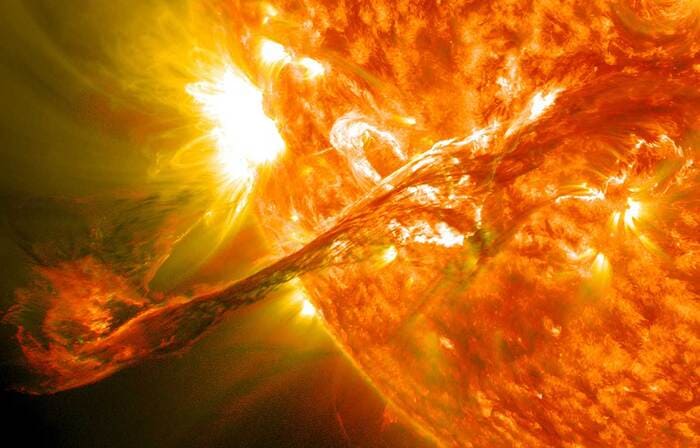
Explosion on the Sun: Solar Strom Coming on Earth, Could Cause Blackouts
A massive explosion on the surface of Suns is happening that was caused by a gas pocket going ablaze, and has released billions of tons of plasma particles.
These solar storms are also coming towards the Earth. The plasma particles are part of solar flares that can cause a major blackout in some places.
The explosion, known as a coronal mass ejection (CME), ejected plasma from the sun’s southwest quadrant, propelling it towards Earth with the aid of powerful solar winds.
Watch the Solar Storm Video on Sun
As per the astronomers, the solar storm was likely to hit the Earth on 27th April or 28th April, but due to some reasons like solar winds shifting the cloud direction, it was taking a longer course to reach the Earth. If this happens can create a blackout on Earth.
As per space science experts, the particles have a 50% probability of disrupting satellites in Earth’s orbit and a 10% chance of causing blackouts. The stream includes powerful radiation that can disrupt Earth’s technology and environment as well.
Creating Geomagnetic Storm
The solar winds are also projected to cause a G1 geomagnetic storm, which might affect satellites orbiting in the region of space.
CMEs have the potential to release billions of tonnes of corona material from the sun’s surface. Plasma and magnetic fields make up the substance.
Such eruptions have the potential to cause space weather, which may disrupt satellites and electrical infrastructures on Earth and be dangerous to exposed astronauts.
The European Space Agency’s Solar and Heliospheric Observatory, which studies our sun, captured it. And the CME particles are only hitting Earth by chance, as the stream was discharged from a coronal hole facing our planet.
Also Read: Earth Day: How Climate Change Affecting the Earth & Humans
The National Oceanic and Atmospheric Administration (NOAA) predicts that the Earth’s magnetic field will be interrupted at 6 p.m. ET tonight, with the disruption lasting until Friday.
According to EarthSky, the Earth’s magnetic field has been ‘unsettled’ since Thursday and will remain so for the next 24 hours as high-speed solar winds pour through the coronal hole. Three coronal holes on the sun’s surface have been detected, as have seven sunspots.
What are Sunspots on Sun?
Sunspots are black areas of the Sun that are colder than the rest of the surface. Solar flares are caused by dark parts of the star. These areas are responsible for solar flares and coronal mass ejections.
When they erupt in the direction of Earth, they may cause geomagnetic storms that generate stunning auroras while also posing a threat to electrical networks and satellites. On Thursday, the sun also emitted a ‘cannibal’ CME on the solar disk’s northeastern edge, pointing away from Earth.
Also Read: New Asteroids Heading Towards the Earth: What NASA says?
This cannibal CME will have no effect on our planet. It is moving away from us, according to SpaceWeather.com.
The sun is an extraordinary cosmic ball of gas that continues to astound astronomers with its perplexing behaviour. In February, a portion of the sun’s northern pole broke off, causing one of these events.
A video depicts a large filament of plasma, or electrified gas, blasting out from the sun, splitting, and then circling in a ‘vast polar vortex.’ While scientists are perplexed, they believe the prominence is related to the reversal of the sun’s magnetic field, which occurs during per solar cycle.
How do these Solar Filaments Occur?
Solar filaments are clouds of charged particles that float above the sun and are held together by magnetic forces. These look like extended, irregular strands shooting out from the surface of the sun.
“Once per solar cycle, it originates near the 55-degree latitude and begins to march up to the solar poles,” said Scott McIntosh, deputy director of the National Centre for Atmospheric Research in Boulder, Colorado.
“It’s pretty strange. It raises a lot of ‘why’ questions. Why does it only migrate towards the pole once before disappearing and reappearing three or four years later in the same region?” said McIntosh.
While scientists have previously detected filaments breaking away from the sun, this is the first time a whirlwind has passed through the area.


